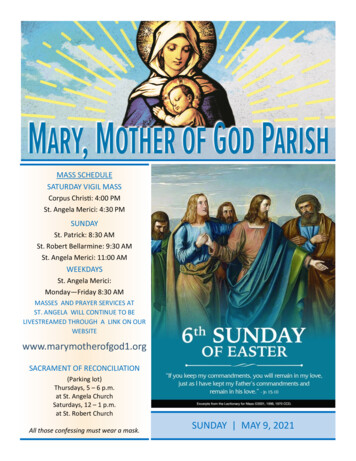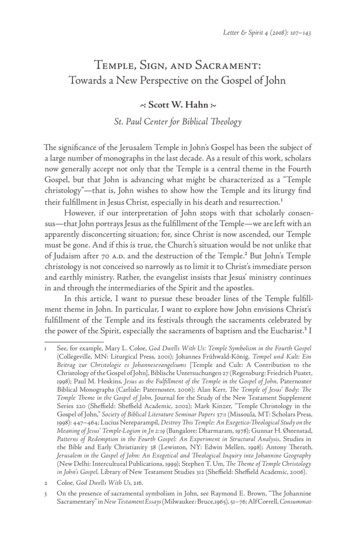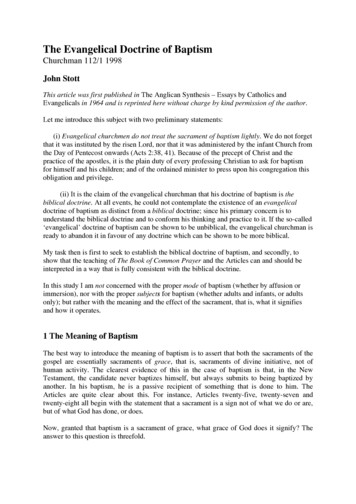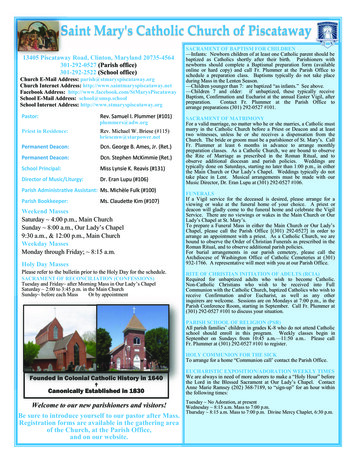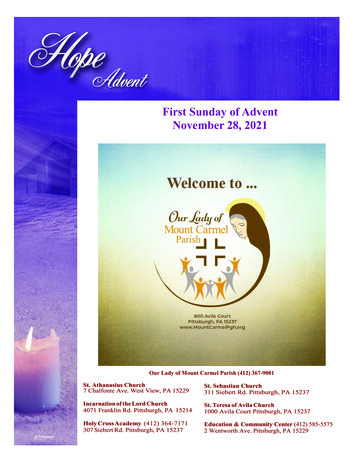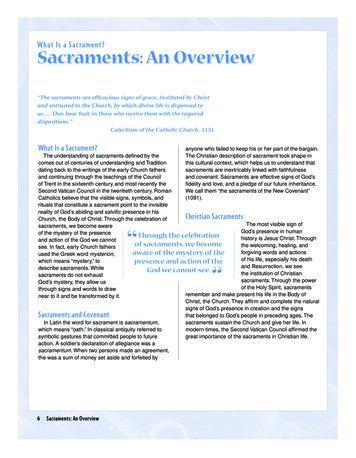
Transcription
What Is a Sacrament?Sacraments: An Overview“The sacraments are efficacious signs of grace, instituted by Christand entrusted to the Church, by which divine life is dispensed tous . They bear fruit in those who receive them with the requireddispositions.”Catechism of the Catholic Church, 1131What Is a Sacrament?anyone who failed to keep his or her part of the bargain.The Christian description of sacrament took shape inthis cultural context, which helps us to understand thatsacraments are inextricably linked with faithfulnessand covenant. Sacraments are effective signs of God’sfidelity and love, and a pledge of our future inheritance.We call them “the sacraments of the New Covenant”(1091).The understanding of sacraments defined by thecomes out of centuries of understanding and Traditiondating back to the writings of the early Church fathersand continuing through the teachings of the Councilof Trent in the sixteenth century and most recently theSecond Vatican Council in the twentieth century. RomanCatholics believe that the visible signs, symbols, andrituals that constitute a sacrament point to the invisiblereality of God’s abiding and salvific presence in hisChurch, the Body of Christ. Through the celebration ofThe most visible sign ofsacraments, we become awareGod’s presence in humanof the mystery of the presenceThrough the celebrationhistory is Jesus Christ. Throughand action of the God we cannotofsacraments,webecomethe welcoming, healing, andsee. In fact, early Church fathersforgiving words and actionsaware of the mystery of theused the Greek word mysterion,of his life, especially his deathwhich means “mystery,” topresence and action of theand Resurrection, we seedescribe sacraments. WhileGod we cannot see.the institution of Christiansacraments do not exhaustsacraments. Through the powerGod’s mystery, they allow usof the Holy Spirit, sacramentsthrough signs and words to drawrememberandmakepresenthis life in the Body ofnear to it and be transformed by it.Christ, the Church. They affirm and complete the naturalsigns of God’s presence in creation and the signsthat belonged to God’s people in preceding ages. TheIn Latin the word for sacrament is sacramentum,sacraments sustain the Church and give her life. Inwhich means “oath.” In classical antiquity referred tomodern times, the Second Vatican Council affirmed thesymbolic gestures that committed people to futuregreat importance of the sacraments in Christian life.action. A soldier’s declaration of allegiance was asacramentum. When two persons made an agreement,the was a sum of money set aside and forfeited byChristian Sacraments““Sacraments and Covenant6Sacraments: An Overview001-019 12AHSA009 CU0758 CEXFMupdated.indd 65/14/12 11:11 AM
“The purpose of the sacraments is to sanctify people,Penance, Anointing of the Sick, Holy Orders, andto build up the Body of Christ, and, finally, to worshipMarriage. This list remains unchanged.God. Because they are signs they also [instruct]”The Catechism of the Catholic Church groups the(Constitution on the Sacred Liturgy, 59). The Councilseven sacraments into three subcategories. Baptism,went on to say that sacraments “nourish, strengthen,Confirmation, and Eucharist are called Sacramentsand express” faith, and lead to a life of charity (59).of Initiation. Penance and Anointing of the Sick areSacraments not only reveal the presence and actionidentified as Sacraments of Reconciliation and Healing.of God, they are also an effectiveFinally, Marriage and HolyCatholics believe thatmeans by which grace—God’sOrders are both consideredown life—is given to us to beSacraments in Service tothe sacraments effect whatshared with others. In a certainCommunion. Such groupingsthey symbolize, when thosesense, the Church is also ahelp to illustrate how all thewhoreceivethemareopensacrament, because the Churchsacraments work together toto God’s grace. Preparation,is a sign of God’s presence andbuild up the Body of Christ.an instrument of grace in theCatholics believe that thecatechesis, and the full use ofworld (CCC, 738, 849).sacramentseffect what theythe sacramental symbols helpsymbolize, when those whous to achieve that opennessreceive them are open toand experience the power ofGod’s grace. Preparation,The Catholic Church teachescatechesis, and the full use ofthe sacraments. Sacramentsthat each of the sacramentsthe sacramental symbols helpare the work of God, notwas instituted by Christ and isus to achieve that opennessrooted in his words and deeds.simply a human customand experience the power of theNaming, enumerating, andor ceremony.sacraments. Sacraments aredefining the sacraments was athe work of God, not simplygradual process, however. Byahumancustomorceremony.Care in preparing forthe thirteenth century the Catholic Church had identifiedandcelebratingthesacramentsopens the way for theirseven sacraments: Baptism, Confirmation, Eucharist,fruitful reception.“Seven Sacraments“For Reflection What experiences of sacraments have helped you become more aware of God’s presence?Sacraments: An Overview001-019 12AHSA009 CU0758 CEXFMupdated.indd 775/14/12 11:11 AM
Baptism“Holy Baptism is the basis of the whole Christian life and the doorwhich gives access to the other sacraments.”Catechism of the Catholic Church, 1213IntroductionThe Sacrament of Baptism confers on us the identityof a Christian and member of the Church, and themission of Christ and the Holy Spirit (CCC, 738). Bywater and the Spirit, those who are baptized becomechildren of God. They share in God’s own life, being thusmarked in Baptism with a dignity and a sacramentalcharacter that can never be taken away.(Romans 6:11). In Jesus’ own baptism the Spirit hoveredover him (Matthew 3:16), foreshadowing the role ofthe Holy Spirit in Christian Baptism. The necessity ofBaptism is expressed in the words of Jesus: “ no onecan enter the kingdom of God without being born ofwater and the Spirit” ( John 3:5 ).Sacrament of InitiationThrough Baptism (one of three Sacraments ofInitiation) we are adopted intoThe essential sign forFor those baptized in infancy, the Church, becoming childrenof God. Incorporated into theBaptism is water. The originalthe role of parents andcommon priesthood of the faithful,Greek verb baptizein meansgodparentsiscrucial,aswe are called to offer our lives toto plunge or immerse.God and reveal to all his kingdomthe faith of the Church isBaptism plunges or immersespassed on by them to the child of justice, love, and peace.us into Christ’s death andInfant Baptism in theResurrection. This is mostfor whom they makeRomanCatholic Church is notvividly experienced when thebaptismal promises and accept accompanied by the Sacramentssacrament is celebrated byof Confirmation and Eucharist,the responsibility or raisingimmersion into the waters ofthe child in the faith with the as it is in the Eastern Catholicbaptismal pools or fonts.Churches. These are normallyIn Baptism, we also receivehelp of the believingreceived at a later age in thethe Light of Christ.communty.Roman Rite, unless the baptizedThe candle lit from the Paschalisan older child or an adult.candle is given with theRegardless,theunityofthese three Sacraments ofexhortation to “walk always as children of the light” (TheInitiation remains.Rite of Baptism for Children, 64). Baptism signifies theSymbolism““enlightenment effected by the grace imparted in thissacrament.The waters of Baptism also signify cleansing andthe purification from all sin. Baptism brings aboutforgiveness of sins and new birth in the Holy Spirit. SaintPaul taught that the baptized share in Christ’s Paschalmystery and so are “dead to sin, but alive for God”8Sacrament of FaithBaptism is a sacrament of faith. For those baptized ininfancy, the role of parents and godparents is crucial, asthe faith of the Church is passed on by them to the child,for whom they make baptismal promises and accept theresponsibility of raising the child in the faith with the helpSacraments: An Overview001-019 12AHSA009 CU0758 CEXFMupdated.indd 85/14/12 11:11 AM
of the believing community.The formation process called the catechumenateleads adults and older children to Baptism. Throughthe religious instruction, prayers, and support ofthe believing commuity, the catechumens are led toembrace the Catholic way of life through Baptism andthe other Sacraments of Initiation with an enlightenedfaith and a willing spiritThe RiteImmersing a catechumen in water, or the pouring ofwater over the head, is the essential sign of Baptism,along with an invocation of the Trinity. While the ordinaryminister of Baptism is a priest or a deacon, anyone canbaptize in an emergency. Anointing with sacred chrism,clothing with a new garment, and the giving of a lightedcandle all express the transformation being broughtabout by the sacrament.For Reflection Which of the images of Baptism is most meaningful to you?Sacraments: An Overview001-019 12AHSA009 CU0758 CEXFMupdated.indd 995/14/12 11:11 AM
Confirmation“For ‘by the Sacrament of Confirmation, [the baptized] are moreperfectly bound to the Church and are enriched with a specialstrength of the Holy Spirit. Hence they are, as true witnesses ofChrist, more strictly obliged to spread and defend the faith by wordand deed.’[LG 11; cf. OC, Introduction 2]”Catechism of the Catholic Church, 1285IntroductionSymbolism and HistoryThe Sacrament of Confirmation celebrates anThe Sacrament of Confirmation was originally aoutpouring of the Holy Spirit and increases his giftsrite that involved the laying on of hands and anointingin us. These gifts give us the opportunity to be strongwith fragrant oil, which immediately followed Baptismin the profession of our faith. Confirmation completesand “confirmed” it. This anointing was carried outbaptismal grace. The Spiritby the bishop. As the younghas already been active in theChurch grew and communitiesConfirmation strengthenssacrament of Baptism, bringingof Christians became moreourbondswiththeChurchto birth a “new creature.”numerous and far-flung, theConfirmation strengthens ourbishop was unable to beand empowers us to witness.bonds with the Church andpresentat every Baptism. TwoJust as the Apostles wentempowers us to witness. Justresponses to this situationforth fearlessly to proclaim the developed. In the Roman Rite,as the Apostles went forthGood News after Pentecost, so the hand-laying and anointingfearlessly to proclaim the GoodNews after Pentecost, so thosewere delayed until a later timethose who receive thewho receive the Holy Spirit’swhen the bishop could carry itHoly Spirit’s outpouringoutpouring in Confirmationout in person. This was the originin Confirmation become thebecome the bearers of gladof Confirmation as a separatebearers of glad tidings intidings in word and deed.sacramental celebration. In theword and deed.Pope Paul VI, in his ApostolicEastern Catholic Churches, onConstitution on the Sacramentthe other hand, the priest whoof Confirmation, said that thisbaptized would anoint the newlysacrament “in a certain way perpetuates the grace ofbaptized immediately. Because the fragrant oil used forPentecost in the Church.” (The Rites, p. 474).this anointing is consecrated by the bishop, the bishop’spresence is considered implicit in the rite itself.““10Sacraments: An Overview001-019 12AHSA009 CU0758 CEXFMupdated.indd 105/14/12 11:11 AM
In the Roman Rite today, the priest who baptizesadults and older children also confirms themimmediately after Baptism. Children who are baptizedas infants in the Roman Rite, however, are confirmedat a later date, usually by the bishop. The unity of thethree Sacraments of Initiation (Baptism, Confirmation,and Eucharist) is a key element of our Catholicunderstanding. When Confirmation is celebrated apartfrom Baptism, therefore, it normally includes both arenewal of baptismal promises and a celebration of theEucharist.The essential Rite of Confirmation is the anointingwith sacred chrism on the forehead. This gesture isaccompanied by the laying on of hands and words thatinvoke the Holy Spirit. In the Eastern Catholic Churches,the oil is called myron, and the sacrament is calledChrismation.Anointed for MissionLike Baptism, the Sacrament of Confirmationconfigures us to Christ. It therefore leaves an indeliblemark upon the soul and can never be repeated. The titleChrist (Christos in Greek) means “the Anointed One.”Anyone who is baptized and confirmed is anointed,as Jesus was, for the mission of sharing the Gospel inword and action. The ancient gesture of anointing withoil calls to mind all of the great figures of Scripture whowere anointed for the special work they were given todo. Every Christian stands in the tradition Jesus himselfclaimed when he read from the book of the prophetIsaiah: “The Spirit of the LORD is upon me, because hehas anointed me ” (Luke 4:18, Isaiah 61:1).For Reflection How does seeing yourself as “anointed” by God help you to understand the Christian life?Sacraments: An Overview001-019 12AHSA009 CU0758 CEXFMupdated.indd 11115/14/12 11:11 AM
Eucharist“ the Eucharist is the sum and summary of our faith: ‘Our way ofthinking is attuned to the Eucharist, and the Eucharist in turn confirmsour way of thinking.’[St. Irenaeus, Adv. haeres. 4, 18, 5: PG 7/s11, 1028.]”Catechism of the Catholic Church, 1327IntroductionSource and SummitThe word “Eucharist” is derived from the Greekword eucharistia, which means thanksgiving. In theEucharistic Prayer, the Church gives thanks to Godthe Father for all the goodness of creation. It givesthanks, above all, for the gift of God’s Son, whosePaschal mystery is the wellspring of our salvation. TheEucharist is the solemn memorial of Christ’s death andResurrection. By keeping this memorial, the Churchfulfills the command of Jesus: “Do this in memory ofme.” (Luke 22:19). In the Eucharist, the sacrifice ofChrist is re-presented, and the faithful share in itsabundant fruits.The Eucharist stands out as the center and high pointof the Church’s whole sacramental life. The SecondVatican Council taught that “the other sacraments,and indeed all ecclesial ministries and works of theapostolate are bound up with the Eucharist and aredirected towards it.” (Decree on the Ministry and Lifeof Priests, 5). In the Eucharist, Christian initiationreaches its culmination, and the Eucharist is repeatedthroughout the Christian life. Indeed, all the way up tothe hour of death, when it is offered as viaticum, theEucharist sustains the faithful on their pilgrim way. It isalso a foretaste of the banquet feast of heaven, and sopoints beyond death to life eternal.12Sacraments: An Overview001-019 12AHSA009 CU0758 CEXFMupdated.indd 125/14/12 11:11 AM
Christ is present in the Eucharist in the gatheredassembly as they pray and sing, in the word of SacredScripture, in the person of the minister, and above all inthe Eucharist. Through the words of consecration andthe power of the Holy Spirit, the bread and wine offeredto the Father in the Eucharist become the Body andBlood of Jesus. Catholics believe in the Real Presenceof Christ under the forms of bread and wine.the Liturgy of the Eucharist. In the Liturgy of the Word,the great works of God are proclaimed and preached,and the people respond with renewed conversion ofheart. In the Eucharist, “thanks is given to God for thewhole work of salvation, and the offerings become theBody and Blood of Christ.” (General Instruction to theRoman Missal, 72). The ministers and the assemblyeach have a part to play in the celebration. In thecelebration of the Eucharist, the reality of the Church isseen.Following the Eucharistic celebration, any of theThe Eucharist is a sacred meal, a paschal banquet.Blessed Sacrament that isShared in communion, thenot consumed is stored in theChrist is present in thesacrament draws the faithfultabernacle, so that he maycloser to Christ and one anotherEucharist in the gatheredbe brought to the sick andin charity and love. It cleanseshomebound, and to the dying.assembly as they pray andand protects them from sin,The reserved Host also receivessing, in the word ofcommits them to the poor whomdue worship and adorationSacred Scripture, in theChrist loved, and gives themfrom the faithful, because ofperson of the minister,spiritual food and drink for theChrist’s continuous presence.journey of life (CCC, 1391–and above all inEucharistic devotions and prayer1397).before the Blessed Sacramentthe Eucharist.The liturgical celebration of theare traditional forms of CatholicEucharist is composed of twopiety encouraged by the Churchmain parts, which together form one act of worship: theas part of the Eucharistic mystery in all its fullness (HolyLiturgy of the Word andCommunion and Worship of the Eucharist OutsideMass, 4).Symbolism and Celebration““For Reflection Which image of the Eucharist is most meaningful for you?Sacraments: An Overview001-019 12AHSA009 CU0758 CEXFMupdated.indd 13135/14/12 11:11 AM
Reconciliation“During his public life Jesus not only forgave sins, but also madeplain the effect of this forgiveness: he reintegrated forgiven sinnersinto the community of the People of God from which sin hadalienated or even excluded them.”Catechism of the Catholic Church, 1443IntroductionReconciliation means to reunite or to come together.Today we use this term along with the terms penance orconfession to name the Sacrament of Healing in whichour sins are forgiven and sinners are reunited to God,the Church, their brothers and sisters, and themselves.In this sacrament through the words and actions of anordained priest, God restores broken and woundedrelationships. The fact that we use several words todescribe this sacrament points to the varied practicesand emphases of the sacrament over the years.Jesus and ReconciliationIn the beginning God “looked at everything he hadmade, and he found it very good.” (Genesis 1:31) Butsin entered the world as a result of the choice of thefirst humans to disobey God and to follow their own willrather than God’s. That choice, which we call originalsin, wounded humanity’s relationship with God and all ofcreation. It ruptured the original harmony that existed14between God and all of creation. Original sin describesthe personal sin of Adam and Eve as well as the fallenstate of humans, which we are all born into. However,the Father did not abandon his creation. He reconcileda sinful world to himself in Jesus Christ, his Son. Jesusbegan his work on earth by preaching repentance“repent and believe in the good news” (Mark 1:15). Hewent beyond preaching to people about repentance andactually welcomed sinners, he ate and drank with them(Luke 5:33–34) and he reconciled them with the Father(Luke 5:17–26 ). His death on the cross was the ultimateact of reconciliation.The Church and ReconciliationThe Church in apostolic times was confident thatBaptism began a new life in which grave sin wouldhave no place. However, it is obvious in the Scripturesof the New Testament that forgiveness and confessionof sin were an important elementSacraments: An Overview001-019 12AHSA009 CU0758 CEXFMupdated.indd 145/14/12 11:11 AM
in the life of the community (James 5:16 ). EventuallyThe revised Rite of Penance highlights the originalsome of the early Christians did sin gravely, forpurpose of the sacrament, which is reconciliation withexample, by giving up their faith under persecution,God and the Church. It emphasizes the importancerather than endure martyrdom. Such public betrayalof conversion and the need to rearrange our livesof Christ was deemed unforgivable by many, asaccording to the holiness and love of God. By providingthree different rites: (1) a rite for Reconciliation that iswere other grave violations of the moral law, such asindividual (one penitent and one priest), as well as amurder or adultery. Yet many such sinners repented,new rite offering communal rites for the celebration ofand wished to return to the relationship with Godthe sacrament (2) for individuals with the priest and (3)and Church that they once had cherished. Clearly,some way had to be found forfor communal celebrations withthe community to be faithfula priest within an assembly,The revised Rite of Penanceto the gospel of mercy, yet torevision affirms that thehighlights the original purpose themaintain its moral standards.celebration of the sacrament isof the sacrament, which isIt was out of this need that theprimarily a liturgical action andreconciliation with God andSacrament of Reconciliationcorporate act of worship whichdeveloped, as a visible andthe Church. It emphasizes the builds up the Body of Christ.ecclesial ritual to reconcileimportance of conversion and It is not a “private function (s),or reunite and come back tobut celebration(s) belongingthe need to rearrange our lives to the Church” (Constitutioncommunity and the sharing in theaccording to the holiness and on the Sacred Liturgy, 26) andEucharist. Throughout the history“Whenever rites, accordingof the Church, the sacramentlove of God.to their specific nature, makehas taken different forms bothprovision for communalpublic and private and individualcelebration involving the presence and activeand communal. However, the basic theology of theparticipation of the faithful, it is to be stressed that thissacrament remained intact, even when differentway of celebrating them is to be preferred, as far asaspects of the sacrament were highlighted in differentpossible, to a celebration that is individual and, so toperiods of Church history.*speak, private” (Constitution on the Sacred Liturgy,27). Interpersonal forgiveness and reconciliation areexpectations of this sacrament. As a Church we stressThe Second Vatican Council declared that “the ritethe relation between Divine forgiveness and forgivingand formularies for the Sacrament of Penance are toour brothers and sisters.be revised so that they more clearly express both the*For further information on the history of Reconciliation,nature and the effect of the sacrament.”““Revision of the Rite of Penancesee pp. 40–41.For Reflection What is the relationship of using the term reconciliation for this sacrament and therevision of the Rite to include communal celebrations?Sacraments: An Overview001-019 12AHSA009 CU0758 CEXFMupdated.indd 15155/14/12 11:11 AM
Anointing of the Sick“‘Heal the sick!’ [Mt 10:8] The Church has received this charge fromthe Lord and strives to carry it out by taking care of the sick as wellas by accompanying them with her prayer of intercession.”Catechism of the Catholic Church, 1509Introductionit calls the faithful to an awareness of the gift that theThe Sacrament of the Anointing of the Sick is rootedsick person brings to the whole community. Christiansin Jesus’ compassion and love for those who are sick.are called to share in the Passion of the Lord. ThoseDuring his lifetime on earth, Jesus touched and healedwho unite their suffering with his become a living signmany who were sick, and taught his followers to doof the Paschal Mystery (Romans 8:17).the same (James 5:14–15). Yet Jesus was more than aThe sacrament is celebrated with anyone who iswonder-worker. He came to call people into a deeperseriously or chronically ill, facing surgery, or infirmrelationship with God and neighbor, healing theirbecause of old age. It is not reserved for those nearspiritual and moral ills as well as their physical ailmentsdeath, but may be celebrated at any time. Anointing(CCC, 1503). He often praisedcan take place in hospitals,those who turned to him inhomes, parish churches, orIndeed, illness can be aneed, sometimes amid greatwherever needed. The Christianformidable trial to the humanobstacles. Indeed, illness can becommunity takes part, prayingperson,butitcanalsobeana formidable trial to the humanfor and with those who are sick.occasion for great faith.person, but it can also be anThe minister of the sacramentoccasion for great faith.is a priest, who anoints theforehead and hands of thesick person with oil blessed by the bishop. When thesacrament is celebrated with the dying, it is usuallyThe Sacrament of Anointing of the Sick draws uponaccompanied by viaticum (communion) and prayers forGod’s power to heal and comfort. It supports thethis unique time.person’s faith in the midst of suffering. Finally,““Sign and RiteFor Reflection 16How has illness and/or healing been an occasion of faithfulness for you?Sacraments: An Overview001-019 12AHSA009 CU0758 CEXFMupdated.indd 165/14/12 11:12 AM
Matrimony“The consent by which the spouses mutually give and receive oneanother is sealed by God himself. [cf. Mk 10:9] From their covenantarises ‘an institution, confirmed by the divine law even in the eyesof society.’[GS 48.1]”Catechism of the Catholic Church, 1639Introductionhowever, such as an exchange of rings. The lovingsupport of the community of faith is expressed throughactive participation in the wedding liturgy.The Sacrament of Matrimony is more than anagreement or a legal contract. It is a covenant, andmust be entered into freely, without coercion, andwith sufficient maturity to make such lasting promises.Marriage requires faithful love, and by its nature alsorequires openness to procreation and the upbringing ofchildren.Through the grace of marriage, each of the spousescalls the other to growth in faith and holiness. The actionof the Holy Spirit working in andthrough their union beckonsMarriage requires faithfulthem to a life of self-giving andlove, and by its nature alsoperfection in following the wayrequires openness toof Christ who dwells in them,procreation and thegiving them strength in times ofupbringing of children.trial and a foretaste of eternity intheir joys.The Sacrament of Matrimony mirrors both the originalblessing of God in creation, and the steadfast love ofChrist for his Church. When a man and a woman enterinto this permanent, lifelong relationship, they vow to befaithful to one another and love one another throughouttheir lives. Marriage is an “intimate partnership of lifeand love” (Pastoral Constitution on the Churchin the Modern World, 48). It is this community andsacramental union that becomes the heart of the family,which is a source of blessing not only for the family andfor the Church, but also for all of society.“Sign and RiteThe priest or deacon whowitnesses the marriage vowsof a couple does so on behalfof the Church, but the man andthe woman are the ministers ofthe sacrament. The vows thatare exchanged are the essential sign and symbol of thesacrament. Additional symbolic actions may be added,“For Reflection Name some marriages in which you have seen signs of God ’s presence.Sacraments: An Overview001-019 12AHSA009 CU0758 CEXFMupdated.indd 17175/14/12 11:12 AM
Holy Orders“This sacrament configures the recipient to Christ by a special grace of theHoly Spirit, so that he may serve as Christ’s instrument for his Church.”Catechism of the Catholic Church, 1581Sacrament of ServiceBishops, Priests, DeaconsHoly Orders, along with the Sacrament of Matrimony,The Sacrament of Orders exists in three degrees.is a Sacrament at the Service of Communion. ThroughThe episcopate (bishops) has the role of teaching,this sacrament, bishops, priests, and deacons aresanctifying, and governing. The presbyterate (priests)empowered by the Holy Spirit for service to the Church.works with the bishop to carry out these ministries,Sustaining the Church’s unity with God and the unityand represents the bishop in local assemblies. Theof the faithful with one another is their constant calling.deaconate (deacons) shares in Christ’s mission byThrough preaching, teaching,assisting bishops and priests,celebrating the sacraments, andand through various forms ofThrough this sacrament,governing the community ofservice.bishops,priests,anddeaconsfaith, they exercise this serviceThe essential rite of Holyare empowered by thefor which Holy Orders preparesOrders is the imposition of thethem.bishop’s hand on the head ofHoly Spirit for service to theThe word communion,Church. Sustaining the Church’s the candidates, with a solemncommunio in Latin and koinoniaconsecratory prayer to theunity with God and the unity ofin Greek, expresses a NewHoly Spirit. Like Baptism andthe faithful with one another is Confirmation, Holy OrdersTestament concept of greatimportance to the Catholicindelibly marks the candidate,their constant calling.understanding of the Church.and cannot be repeated orCommunion is the unity of heartconsidered temporary. Theand mind that comes from the Holy Spirit. Communionministerial priesthood is different from the priesthood ofis experienced first of all in the renewed relationshipall the baptized, yet all find their inspiration and model inof love between the human race and God, won byJesus Christ.the cross of Christ. It then spills over into a renewedrelationship of humans with one another.““For Reflection 18Why is ordination important for the life of the Church?Sacraments: An Overview001-019 12AHSA009 CU0758 CEXFMupdated.indd 185/14/12 11:12 AM
of God, they are also an effective means by which grace—God’s own life—is given to us to be shared with others. In a certain sense, the Church is also a sacrament, because the Church is a sign of God’s presence and an instrument of grace in the world (CCC, 738, 849). Seven Sacraments The Catholic Ch
